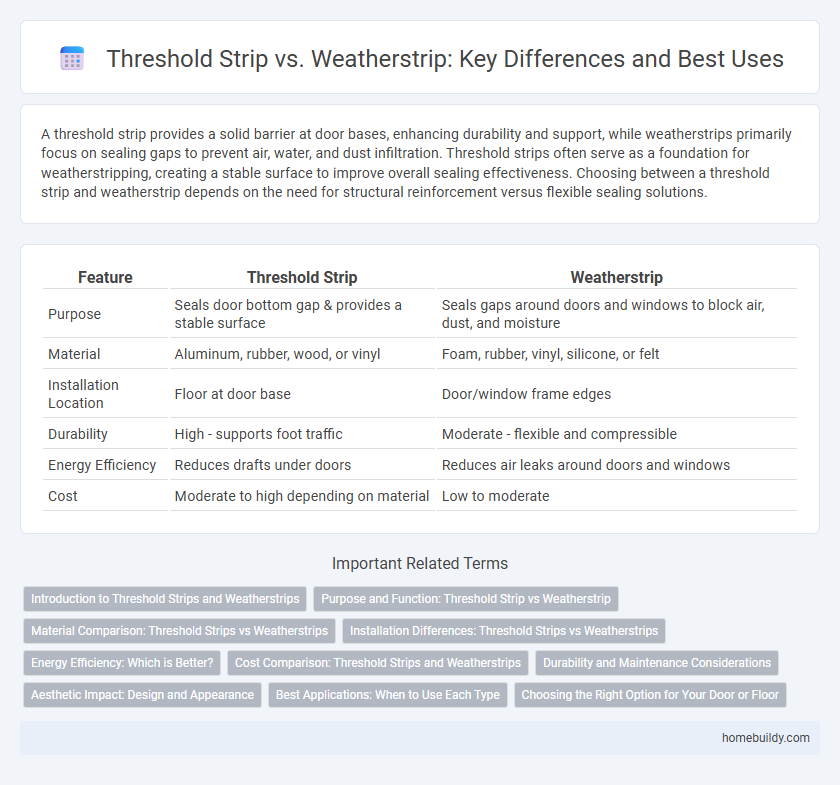A threshold strip provides a solid barrier at door bases, enhancing durability and support, while weatherstrips primarily focus on sealing gaps to prevent air, water, and dust infiltration. Threshold strips often serve as a foundation for weatherstripping, creating a stable surface to improve overall sealing effectiveness. Choosing between a threshold strip and weatherstrip depends on the need for structural reinforcement versus flexible sealing solutions.
Table of Comparison
| Feature | Threshold Strip | Weatherstrip |
|---|---|---|
| Purpose | Seals door bottom gap & provides a stable surface | Seals gaps around doors and windows to block air, dust, and moisture |
| Material | Aluminum, rubber, wood, or vinyl | Foam, rubber, vinyl, silicone, or felt |
| Installation Location | Floor at door base | Door/window frame edges |
| Durability | High - supports foot traffic | Moderate - flexible and compressible |
| Energy Efficiency | Reduces drafts under doors | Reduces air leaks around doors and windows |
| Cost | Moderate to high depending on material | Low to moderate |
Introduction to Threshold Strips and Weatherstrips
Threshold strips provide a durable barrier at door bases to prevent drafts, dust, and moisture, enhancing energy efficiency and maintaining indoor comfort. Weatherstrips are flexible sealing materials installed along door and window edges to block air leakage and improve insulation performance. Both components serve distinct functions in weatherproofing, with threshold strips primarily sealing the floor gap and weatherstrips sealing the perimeter edges.
Purpose and Function: Threshold Strip vs Weatherstrip
Threshold strips create a sealed barrier at door bottoms to prevent drafts, dust, moisture, and pests from entering, enhancing energy efficiency and comfort. Weatherstrips are installed around door and window edges to fill gaps, blocking air leaks and improving insulation by adapting to frame contours. Both components work together to maintain indoor climate control, but threshold strips specifically focus on the door floor interface while weatherstrips address perimeter sealing.
Material Comparison: Threshold Strips vs Weatherstrips
Threshold strips are typically made from durable materials like aluminum, stainless steel, or hardwood, designed to withstand heavy foot traffic and provide a sturdy seal at door bases. Weatherstrips often utilize flexible materials such as rubber, silicone, vinyl, or foam, enabling them to compress and create airtight seals around door or window edges. The rigidity of threshold strip materials offers structural support and a robust barrier against drafts, while the elasticity of weatherstrip materials ensures adaptability to varying gaps for enhanced insulation.
Installation Differences: Threshold Strips vs Weatherstrips
Threshold strips are typically installed at the base of doors to create a seal between the door and the floor, requiring precise measurement and often screwing into the subfloor or door frame. Weatherstrips, on the other hand, are applied along the edges of doors or windows and can be attached using adhesive backing, nails, or screws, depending on the material and surface. The installation complexity of threshold strips usually involves more structural adjustments compared to the simpler, surface-level application of weatherstrips.
Energy Efficiency: Which is Better?
Threshold strips provide superior energy efficiency by sealing gaps under doors, preventing drafts and heat loss more effectively than traditional weatherstrips designed primarily for window frames. Their robust materials and design create a tighter barrier against air infiltration, reducing energy consumption for heating and cooling. For homeowners aiming to maximize insulation and lower utility bills, threshold strips offer a more durable and energy-saving solution compared to standard weatherstripping options.
Cost Comparison: Threshold Strips and Weatherstrips
Threshold strips generally have a lower upfront cost compared to weatherstrips due to simpler materials and installation processes. Weatherstrips, often made from flexible rubber or foam, can provide better insulation, which may lead to long-term energy savings despite their higher initial price. Evaluating both options requires balancing immediate budget constraints against potential efficiency improvements and durability.
Durability and Maintenance Considerations
Threshold strips typically offer greater durability than weatherstrips due to their rigid, often metal or hard plastic construction, making them ideal for high-traffic doorways. Weatherstrips, usually made from flexible materials like rubber or foam, require more frequent replacement and maintenance due to wear and tear from temperature changes and exposure to moisture. Choosing threshold strips can reduce long-term upkeep costs and provide a more robust seal against drafts and debris.
Aesthetic Impact: Design and Appearance
Threshold strips provide a clean, streamlined finish at door bases, enhancing the overall aesthetic with minimal visual disruption compared to weatherstrips, which often appear bulkier or less refined. The design of threshold strips integrates seamlessly with flooring materials, offering a sleek transition that complements interior decor. Unlike weatherstrips, threshold strips maintain a consistent appearance without protruding elements, preserving the doorframe's architectural integrity.
Best Applications: When to Use Each Type
Threshold strips are ideal for sealing gaps beneath doors to prevent drafts, moisture, and pests, making them perfect for exterior doorways and heavy foot traffic areas. Weatherstrips excel in sealing movable components such as windows and door frames, providing flexible protection against air and water infiltration. Use threshold strips where a durable, low-profile barrier is needed on the floor, while weatherstrips are best suited for creating airtight seals around window sashes and door edges.
Choosing the Right Option for Your Door or Floor
Threshold strips provide a sturdy seal at the junction between door bottoms and floors, preventing drafts, moisture, and debris infiltration while supporting door weight. Weatherstrips, made of flexible materials like foam or rubber, effectively seal gaps around door frames to enhance energy efficiency by blocking air leaks. Selecting the right option depends on the specific sealing needs, with threshold strips ideal for floor-level barriers and weatherstrips suited for comprehensive door frame insulation.
threshold strip vs weatherstrip Infographic

 homebuildy.com
homebuildy.com